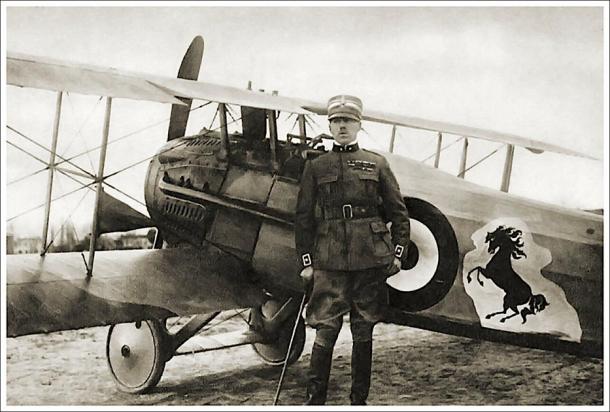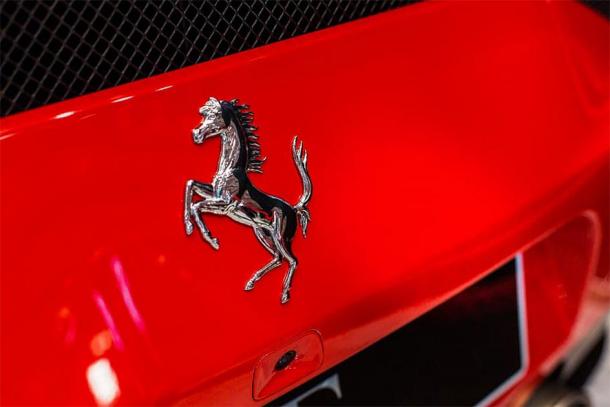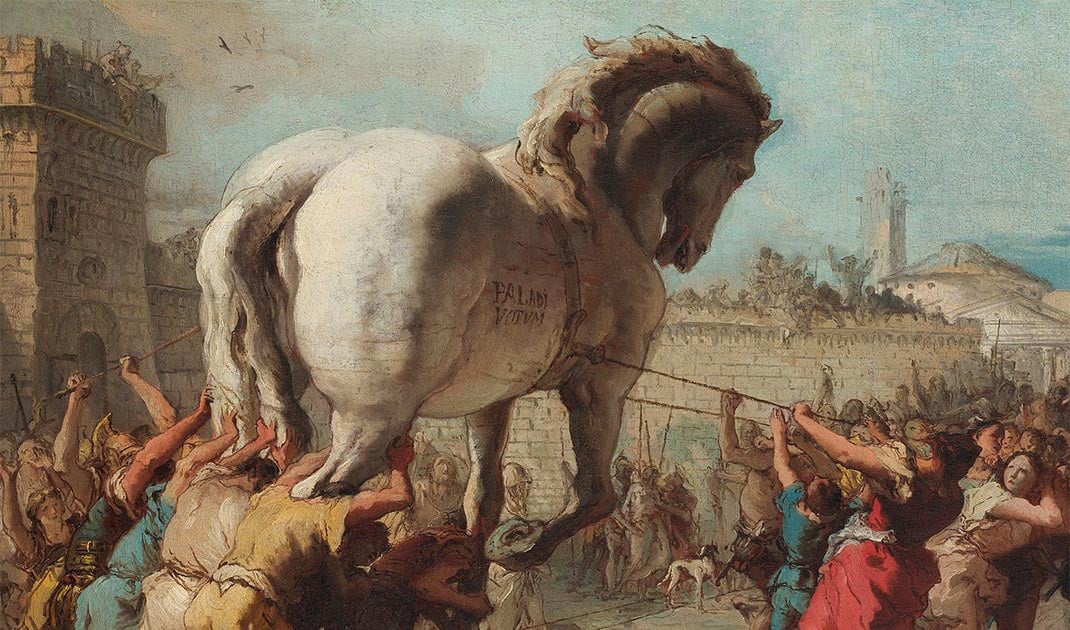Unravelling the True Story of the Legendary Trojan Horse
The Trojan horse really exists, or rather did exist until a few years ago.
It is a horse that has crossed history over the last 3,000 years, who has made poets, princes, kings, and emperors fall in love with it. It has fought in all the most important wars, won memorable races, traveled all over the known world and then died out less than 50 years ago, just a step away from the 21st century.
The Trojan War and the Horse That Left its Mark
Everyone remembers how the siege of the city of Troy ended, narrated by the poet Homer around the 12th century BC. It was Ulysses who devised the winning stratagem after 10 years of ruthless war between the Acheans, who besieged the city, and the Trojans who defended it. Odysseus pretended to abandon the battlefield and retreat with his ships. Before leaving the beach, however, he designed a huge wooden horse, making it look like a propitiatory act towards Poseidon. The horse was in fact one of the symbols with which he was depicted.
Inside the statue, Ulysses hid himself, fully armed, together with about fifty warriors. The Trojans, convinced that the long siege had finally come to an end, dragged the horse inside the walls as spoils of war. When the tired and drunken Trojans went to sleep late at night, the fifty brave Acheans had no difficulty in getting out of the horse, opening the city gates to the rest of the army, which had meanwhile returned from the beach, and then conquered the city together.
To the modern readers of Homeric poems it may have seemed a great naivety to bring that votive sculpture within the walls of the city. But it is important to know that for the Trojans, the horse, their horse, was sacred. It was an animal that was bred with maniacal care, selecting the best specimens for courage, strength, endurance and above all speed. They were horses with white livery (although technically we should say grey) of small to medium stature (especially by today's standards) and "not beautiful but fast" as described around 500 BC by the historian and geographer Hecataeus of Miletus.
The first mention of these horses can be found in the Iliad where they are present in the "Catalogue of Heroes" (book II, 851-852) in which Homer tells of the attempt by the Venetians of Paphlagonia, allies of the Trojans, to free the city. Paphlagonia was a region of present-day Turkey, not far from Troy where, Homer writes, "the race of wild mules was born".
Still today, however, not all historians and archaeologists believe the legend of the wooden horse. Some claim it was a Phoenician boat with a horse-shaped figurehead called hippos, others a catapult similar to a horse's head. The only real Trojan horse of which one can be absolutely certain of, is the tenacious, brave and very fast white horse of the Venetians of Paphlagonia.
The Trojan Horses That Survived the War
Homer tells us that the head of the Venetians, Pylaemenes was killed in battle by Menelaus, King of Sparta and husband of Helen, the woman for whom the fierce war between the Acheans and Trojans originated. Meanwhile in Paphlagonia, taking advantage of the absence of the army engaged in the war in Troy, there was an insurrection. The Venetian soldiers, therefore, having to flee from the burning city and not being able to return to their land, joined the wise Trojan Antenor.

Depiction of a battle during the Trojan War, including horses and chariots, where Menelaus fought Paris. (Los Angeles County Museum of Art / Public domain)
He led them and their herd of precious surviving horses from the coasts of the Black Sea to the lagoon of Venice. The migration is also testified by the Roman historian Titus Livy in his essay Ab urbe condita, where he explains that Venetians and Trojans arrived “in the innermost gulf of the Adriatic Sea, in the land of the Euganeans, between the sea and the Alps.”
From there they settled in various encampments that later became important cities such as Padua, Treviso and Belluno, going as far as Santa Lucia in Slovenia. In particular the Venetian horse breeders found their place of election along the Piave River, so that after several centuries, their horses took the name of Venetian Horses of the Piave breed.
Ancient and Unanimous Nobility of the Piave Breed
From then on, very few animals can claim such an ancient and unanimous license of nobility in their pedigree. In classical Greece, these horses are honored by poets, historians and writers for their speed, endurance and immaculate ivory cloaks. The Spartan poet Alcman, for example, in the 7th century BC compared them to the woman he loved to enhance their beauty.
Here are his immortal verses: "She presents herself to us so beautiful, as if she were standing in the midst of a flock of sheep, a vigorous horse, triumphant in races, with her hooves resounding with winged dreams. Do you see him? He is a Venetian purebred."
One of the greatest Athenian tragic poets, Euripides, also deals with this splendid animal several times. For example, in the 5 th century poem "Hippolytus", he writes: "Artemis, lady of Limma Marittima and the rumbling stadiums of horses, oh to be in your plains, to be able to tame the foals from Veneto."
Before that, there had been Hesiod, Pindar and many others, until 440 BC when charioteer Leo Spartan won the 85th Olympics with a pair of mares from Veneto. From that day on, this breed also became sacred to the Greeks, so much so that Leo wanted an inscription dedicated to the Venetian horses in his statue.
In the meantime, the Venetians made the horse their reason for living. This ancient and noble people called the horse "Evko", an Indo-European word similar to the Latin "equus" and the Sanskrit "akvas". A root that can still be found today in several places such as il Cavallino (Equilium), a peninsula in front of Venice, or Acelum a hilly village near Treviso, present in the list of the most beautiful villages in Italy, where the famous prosecco wine is produced.
In these lands, the breeding and trade of horses became one of the main drivers of their economy. The discovery of coins in the areas around the Piave River, Corinth, Syracuse and Magna Graecia, evidenced a flourishing trade.
The Greek historian Strabo, who lived at the turn of the first century, also tells us that the Venetians used to mark each of their horses with a wolf-shaped mark and for this reason they were also called “Lycophore,” which in Latin means wolf bearer. This tradition lasted until the last horse of the Piave breed died out about forty years ago. Strabo had the opportunity to see one of these horses himself, which was branded with the wolf's head.
Importance to the Roman Empire
Even in ancient Rome the horses from Veneto had a special place. The Roman cavalry constantly supplied itself with horses and riders from Veneto, of which it always sought an alliance. The trust given by the Romans to these warriors and breeders was well placed, because the Venetians had enormous glory in battle. Among the many successes, the most celebrated was the tragic and bloody battle of Talamone against the Celts, who in 225 BC were annihilated by a coalition of four Roman legions, a contingent of Etruscans and precisely the Venetian cavalry.
But in Rome, if possible, the Venetian coursers were even more famous in times of peace. In the ludi circenses, the famous public games held at the Circus Maximus or the Colosseum, Venetian horses were the stars of chariot races. The most popular and beloved attraction along with gladiator fights.
The ‘Veneta factio’ ran with the blue insignia, the national color of the Veneti inspired by the linen flower that these people were expert growers and competed in a lane specially dedicated to it. Still nowadays, in the numerous re-enactments that are organized in Rome for tourist purposes, ‘the Blues’ are the main attraction.

Mosaic depicting a charioteer and a horse from the Veneta factio (Blue) from 3 rd century AD in Palazzo Massimo all Terme, Rome. (Carole Raddato / CC BY-SA 2.0)
The Middle Ages and Napoleon’s Obsession
At the beginning of the Middle Ages, after the fall of the Roman Empire, a particular variety of more sturdy Veneto horses called "Paduan" were established, suitable to support the heavy armor of medieval knights during the numerous bloody battles or to transport the large chariots with supplies and goods. The painter, sculptor and architect Donatello, immortalized this noble steed in Padua in the famous equestrian monument dedicated to Gattamelata, an Italian warlord who fought in Veneto in the mid-15 th century.
- The Construction of Venice, the Floating City
- Horses as Symbols of Power in History and Mythology
- Giddyap! How the Stirrup Revolutionized Horseback Riding and Helped Build Empires

Statue of the Gattamelata. (photo taken by the author)
In that period, needs, habits and lifestyles changed. New pastimes such as the carousel, the palio and the tournament became established, where these mighty animals were the most celebrated heroes. Shakespeare also took care of them, as in the “Taming of the Shrew” quotes them: Gremio: "And I would gladly give my horse, the best in Padua, to that man who began to seriously court her...".
Among the most prestigious horse rides of the time, there is certainly that of Verona, also mentioned by Dante in the VX of Hell (Divine Comedy). A popular entertainment that already in the 12 th century saw women competing too.
The fame of these horses, now widespread throughout Europe and Asia Minor, was the origin of great exhibitions including the “Fiera dei Cavalli e dei Morosi” near Verona and the “Fiera di Santa Lucia” near Treviso. Both of them are still held today and have abundantly over a thousand years of history.
The Fiera di Santa Lucia, in particular, boasts a two-thousand-year history, being the heir of a previous paleo-Venetian exhibition of sacred horses dedicated to the god of light Lugh, which later developed and became international around the 6 th century with the reign of the Franks.
Venetian horses were then exported to improve local breeds in France, Belgium, Holland, the Balkans and even Asia Minor. This was well known to horse connoisseurs, such as the French. So much so, that between the end of 1700 and the beginning of 1800, Napoleon organized six conquest campaigns in Veneto during which he ordered his army to raid horses.

Napoleon on horseback (which could be of the Venetian breed). (CC BY 2.0)
Within the blood of these famous white horses of which the French emperor loved so much, it would seem that Trojan/Venetian blood was flowing. Once he had conquered Venice, Napoleon plundered it by stealing more than thirty thousand works of art of inestimable value, including Tiziano, Mantegna and Veronese.
The most brutal and unbearable spoliation for the Venetians, however, was that of St. Mark's horses. A sculptural group of four bronze horses dating back to the 2 nd century BC, which the Venetians had taken from the Hippodrome of Constantinople, because they celebrated their victories with their horses' chariots. The event is also documented by a press release dated 1797 (entitled: The French troops steal St. Mark's horses), which sees a Piazza San Marco crowded with French soldiers intent on transporting the precious relic.

The magnificent bronze horses of St. Mark's Basilica. (Nick Thompson / CC BY-NC-SA 2.0)
The Greatest Admirer: The Hapsburg Empire
The greatest buyer and admirer of Venetian horses, however, was probably another empire, the Hapsburg Empire. Already from its birth the Austro-Hungarians had begun to attend the equine fairs of the Veneto in search of horses of great resistance and courage to equip their cavalry or their imperial carriages.
It is therefore more than likely that the famous Princess Sissi (wife of Franz Joseph of Hapsburg) used Venetian horses during her travels and parades. Sissi, who was also a great equestrian rider and lover of long rides, lived in Venice for 7 months, between 1862 and 1863, to cure herself of a nervous illness. At this point she came into direct contact with the places where these horses were born.

The Empress of the Hapsburg Empire, Elisabeth Amelie Eugenie of Wittelsbach, known as Sissi, posing on a horse in 1896 in Biarritz, France. (Unidentified photographer / Public domain)
But there is a further circumstance that ties the Venetian horses to Vienna and the Hapsburgs, namely the Lipizzaner horses of the Spanish riding school in Vienna, which is the oldest riding school of its kind in the world. This academy still gathers tourists from all over the world and uses exclusively Italian Lipizzaner horses.
The Lipizzaners are very vigorous white horses (technically grey as mentioned above), which owe their name to their origin, the town of Lipizzaner (now in Slovenia), located less than 100 kilometers (62 mi) south of the aforementioned St. Lucia in Slovenia, where one of the first camps of Venetians and Trojans fleeing the burning city settled.
Among the first evidence of this Lipizzaner breed is documentation in relation to the sale of a land with horses attached, dated 1580. Tracing this document we learn that they come from some mares in Verona and Aquileia. These are the very places where the Venetians had set up some of the oldest horse farms. After all, it is enough to take a look at the statue of Gattamelata and compare it to a modern Lipizzaner to notice remarkable similarities.
A First World War Hero That Inspired the Ferrari Horse
The last moment of glory of the Piave horses was during the First World War, where thanks to them the enemy was stopped on the Piave River, the land where more than three thousand years before they were first bread. Brave and tireless, they dragged the wagons along the line of fire, carrying weapons, supplies and rescuing the wounded. They ran between the wards to bring orders, launched attacks and resisted in battle without eating or drinking for days.
But the greatest legacy that this mythological animal managed to leave to the 21 st century is due to one of the most intrepid top guns of the First World War, Francesco Baracca, ace of the skies who remained unbeaten throughout the war winning 34 air duels fought with his SPAD VII (for some battles XIII) fighter jet on the Piave line. It's no coincidence that his heraldic insignia on the left side of his plane was a prancing horse.

Francesco Baracca with his SPAD fighter jet with the prancing horse logo that later became the emblem of Ferrari. (Tom Wigley / CC BY-NC-SA 2.0)
To date, it is not clear why this aviator, coming from the cavalry, had chosen the little horse as his symbol of battle. It is reasonable to suppose that he admired the value of the Venetian steeds he saw fighting under him and therefore, he had chosen the model horse for inspiration. He who, even as a knight, had fought in the saddle of one of these strong animals and even when he was already flying for some time, he was still portrayed in the photos with the spurs.
Francesco Baracca then died in battle from a rifle shot fired from the ground a few hundred meters from the course of the Piave River. At the end of the war, in 1923, a young and brilliant Italian engineer named Enzo Ferrari, fascinated by the deeds of the war hero, asked for and obtained from Francesco Baracca's mother the use of the symbol to build his sports cars.
Since then, the Ferrari/Cavallino rampante duo has been synonymous worldwide with speed, intrepidness, charm and power. The same values and virtues that those ancestral horses have been able to express throughout the course of human history.

The classic Ferrari car emblem, which was inspired by the Italian war hero Francesco Baracca and the Venetian horse. (CC0 1.0)
After the First World War, the mechanization of the countryside and mass motorization marked the decline of this breed. In an advertisement for a Fiat commercial vehicle in 1931, the text explicitly said: “He is more docile than a horse, faster and when he is not working, he does not eat.”
The Veneto horse still resisted as a pet and recreational animal in the most remote areas of eastern Veneto until it was declared extinct in 1974. At the beginning of the new millennium a project of the Veneto region began a genetic study to try to reconstitute it, but at the moment there is still nothing official.
Top image: Detail from The Procession of the Trojan Horse in Troy painting. (Giovanni Domenico Tiepolo / Public domain)
By Paolo Latini
References
Alcman. n.d. The First Partheneion. De Gruyter.
Euripides. c.428 BC. Hippolytus. Bloomsbury Publishing PLC.
Franko, G. 2006. The Trojan Horse at the Close of the "Iliad". The Classical Journal, Vol. 101, No. 2 (Dec. - Jan., 2005/2006).
Gerosa, G. 2017. Napoleone. Un rivoluzionario alla conquista di un impero. Mondadori
Hecataeus of Miletus. n.d. Periodos ges. n.p.
Hesiod. c.700 BC. Theogony. Strategic Book Publishing & Rights Agency LLC.
Homer. c.1180 BC. The Iliad. Penguin Classic.
Homer. c.700 BC. The Odyssey. W. W. Norton & Company.
Livy, T. c.9 BC. Ab urbe condita. Vandenhoeck & Ruprecht Gmbh & Co.
Pindar. c.464 BC. Olympian VII. Cambridge University Press.
Polibio. c.150 BC. Storie. Testo greco a fronte. BUR Biblioteca Univ. Rizzoli
Razza Piave, Emanuele Bellò, Sismondi Editore.
Tibon, F. 2017. La presa di Troia. Un inganno venuto dal mare. Ediz. Storia e Studi Sociali.



















